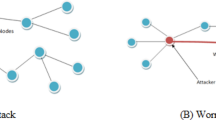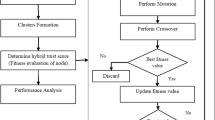Abstract
Wireless Sensor Networks becomes robust while the nodes possessing the self-configuring capability by which they can be either keeping themselves as a part of the network or they can also simply leave. The transmission of Data is achieved through the inter communication among the nodes participated in the network. For most participative nodes, there is a possibility of energy depletion and thus the network dies despite the other nodes having optimal energy for being operative. Bring decentralized, another classical challenge for WSNs is the threat of intrusion detection which may arise DoS attacks that depleted the energy as well. Major works in the literature focuses either attempts to address the Intrusion detection to fix DoS attacks or keep the optimal energy level by introducing energy preserving strategy and dynamic clustering strategy so that the network lifetime could be extended. This work deals with the hybrid model in which the nodes are clustered together to form the Connected Dominating Set so that the data transmission could be augmented. The objective of the system is to include only nodes with adequate energy that can ensure the validity of the network by marking them as CDS node. The CDS probability of a node depends on foresight of the energy of the participant nodes till the transmission. Packet distribution is done based on the CDS of the node and thus the inappropriate network breakdown that keeps same node waking so often could be avoided. Thereby, retransmission has been avoided due to packet drops, which also conserved the energy of the network. From the simulation results, it is understood that the technique decreases the loss of packets and deferment. The simulation results demonstrated that the proposed model has improved performance metrics such as goodput, throughput, packet dropping ratio. Also, it is seen that the network lifetime has been significantly increased to 50% meantime packet dropping ratio has been reduced to 50% with the energy consumption little lower than 3% when compared with the preliminary enhanced energy-dependent constraint DoS (denial-of-service) detection model and thus the network seems fault-proof and extended reliable.















Similar content being viewed by others
References
Ahmad A, Javaid N, Qasim U, Ishfaq M, Khan ZA, Alghamdi TA (2014) RE-ATTEMPT: a new energy-efficient routing protocol for wireless body area sensor networks. Int J Distrib Sens Netw 10(4):464010
Alghamdi T (2018) Secure and energy efficient path optimization technique in wireless sensor networks using DH method. IEEE Access 4:53576–53582
Chu Y, Mitchell PD, Grace D (2012) Aloha and Q-learning based medium access control for wireless sensor networks. In: Proc. International Symposium on wireless communication systems (ISWCS), pp 511–515
Dehghani S, Pourzaferani M, Barekatain B (2015) Comparison on energy-efficient cluster-based routing algorithms in wireless sensor network. Proc Comput Sci 72:535542
Del-Valle-Soto C, Mex-Perera C, Nolazco-Flores JA, Velázquez R, Rossa-Sierra A (2019) Wireless sensor network energy model and its use in the optimization of routing protocols. Energies 13(3):1–33
Ennaciri A, Erritali M, Bengourram J (2019) Load balancing protocol (EESAA) to improve quality of service in wireless sensor network. Proc Comput Sci 151:1140–1145
Fasolo E, Rossi M, Widmer J, Zorzi M (2007) In-network aggregation techniques for wireless sensor networks: a survey. IEEE Wirel Commun 14(2):70–87
Fu L, Qin Y, Wang X, Liu X (2011) Converge-cast with mimo. In: IEEE INFO COM, pp 649-657
Galzarano S, Savaglio C, Liotta A, Fortino G (2013) Gossiping-based AODV for wireless sensor networks. In: Proceedings of IEEE International Conference on systems, man and cybernetics, pp 26-31
Ganesh S, Amutha R (2013) Efficient and secure routing protocol for wireless sensor networks through SNR based dynamic clustering mechanisms. J Commun Netw 15(4):422429
Gubbi J, Buyya R, Marusic S, Palaniswami M (2013) Internet of things (IoT): a vision, architectural elements, and future directions. Future Gener Comput Syst 29(7):1645–1660
Gupta P, Kumar PR (2000) The capacity of wireless networks. IEEE Trans Inf Theory 46(2):388–404
Huang M (2018) A services routing based caching scheme for cloud assisted CRNs. IEEE Access 6:15787–15805
Huebscher MC, McCann JA (2008) A survey of autonomic computing’ degrees, models, and applications. ACM Comput Surveys 40(3):1–28
Hu Y, Shen X, Kang Z (2009) Energy-efficient cluster head selection in clustering routing for wireless sensor networks. In: Proc. 5th Int. Conf. wireless communication network mobile comput. (WiCOM), p 14
Hussain S, Matin AW, Islam O (2007) Genetic algorithm for energy efcient clusters in wireless sensor networks. In: Proc. 4th International Conference on Information Technology (ITNG), pp 147–154
Jafari H, Nazari M, Shamshirband S (2018) Optimization of energy consumption in wireless sensor networks using density based clustering algorithm. Int J Comput Appl 43:1–10
Joshi GP, Nam SY, Kim SW (2013) Cognitive radio wireless sensor networks: applications, challenges and research trends. Sensors 13(9):11196–11228
Li X, Guan Z-H (2013) Energy-aware routing in wireless sensor networks using local betweenness centrality. Int J Distrib Sensor Netw 9(5):307038
Li J, Hu H, Ke Q, Xiong N (2017) A novel topology link-controlling approach for active defense of nodes in networks. Sensors 17(3):553
Liu A, Chen Z, Xiong NN (2018a) An adaptive virtual relaying set scheme for loss-and-delay sensitive WSNs. Inf Sci 424:118136
Liu Y, Ota K, Zhang K, Ma M, Xiong N, Liu A, Long J (2018b) QTSAC: an energy-efficient MAC protocol for delay minimization in wireless sensor networks. IEEE Access 6:8273–8291
Luo C, Wu F, Sun J, Chen CW (2009) Compressive data gathering for large-scale wireless sensor networks. In: ACM Mobi Com, pp 145–156
Mahmood A, Shi K, Khatoon S, Xiao M (2013) Data mining techniques for wireless sensor networks: a survey. Int J Distrib Sens Netw 9(7):406
Moorthi M, Thiagarajan R (2020) Energy consumption and network connectivity based on Novel-LEACH-POS protocol networks. Comput Commun 149:90–98
Pottie GJ, Kaiser WJ (2000) Wireless integrated network sensors. ACM Commun 43(5):51–58
Qiu T, Zhang Y, Qiao D, Zhang X, Wymore ML, Sangaiah AK (2018) A robust time synchronization scheme for industrial Internet of Things. IEEE Trans Ind Inf 14(8):3570–3580
Saracevic M, Adamovic S, Bisevac E (2018) Applications of Catalan numbers and Lattice Path combinatorial problem in cryptography. Acta Polytech Hung 15(7):91–110
Saracevic M, Adamovic S, Miskovic V, Macek N, Sarac M (2019) A novel approach to steganography based on the properties of Catalan numbers and Dyck words. Future Gener Comput Syst 100:186–197
Savaglio C, Pace P, Aloi G, Liotta A, Fortino G (2019) Lightweight reinforcement learning for energy efficient communications in wireless sensor networks. IEEE Access 7:29355–29364
Sharma VK, Shukla SSP, Singh V (2012) A tailored Q- learning for routing in wireless sensor networks. In: IEEE Access, pp 663–668
Suryaprabha E, Saravana Kumar NM (2020) Enhancement of security using optimized DoS (denial-of-service) detection algorithm for wireless sensor network. Soft Comput 24:10681–10691
Tang J, Liu A, Zhang J, Xiong NN, Zeng Z, Wang T (2018) A trust-based secure routing scheme using the traceback approach for energy-harvesting wireless sensor networks. Sensors 18(3):751
Tian X, Zhu Y-H, Chi K, Liu J, Zhang Daqiang (2017) Reliable and energy-efficient data forwarding in industrial wireless sensor networks. IEEE 11(3):1424–1434
Tianshu W, Gongxuan Z, Xichen Y, Ahmadreza V (2018) Genetic algorithm for energy-efficient clustering and routing in wireless sensor networks. J Syst Softw 146:196–214
Tunca C, Isik S, Donmez MY, Ersoy C (2015) Ring routing: an energy-efficient routing protocol for wireless sensor networks with a mobile sink. IEEE Trans Mob Comput 14(9):19471960
Wang Li XX, Leung VCM (2015) Artificial intelligence-based techniques for emerging heterogeneous network: State of the arts, opportunities, and challenges. IEEE Access 3:1379–1391
Wang Q, Guo S, Hu J, Yang Y (2018) Spectral partitioning and fuzzy C-means based clustering algorithm for big data wireless sensor networks. J Wirel Commun Netw 2018:54. https://doi.org/10.1186/s13638-018-1067-8
Yogeesh AC, Shantakumar BP, Premajyothi P (2016) A survey on energy efficient. Secure routing protocols for wireless sensor networks. Int J Comput Sci Eng 5(8):17702–17709
Zaman N, Jung L T, Yasin M M (2016) Enhancing energy efficiency of wireless sensor network through the design of energy efficient routing protocol. Sensors 2016:1–16
Zhu E, Zhang Y, Wen P, Liu F (2019) Fast and stable clustering analysis based on grid-mapping K-means algorithm and new clustering validity index. Neuro-computing 363:149–170
Author information
Authors and Affiliations
Corresponding author
Additional information
Publisher's Note
Springer Nature remains neutral with regard to jurisdictional claims in published maps and institutional affiliations.
Rights and permissions
About this article
Cite this article
Saravana Kumar, N.M., Suryaprabha, E. & Hariprasath, K. Machine learning based hybrid model for energy efficient secured transmission in wireless sensor networks. J Ambient Intell Human Comput 13, 887–902 (2022). https://doi.org/10.1007/s12652-021-02946-y
Received:
Accepted:
Published:
Issue Date:
DOI: https://doi.org/10.1007/s12652-021-02946-y




